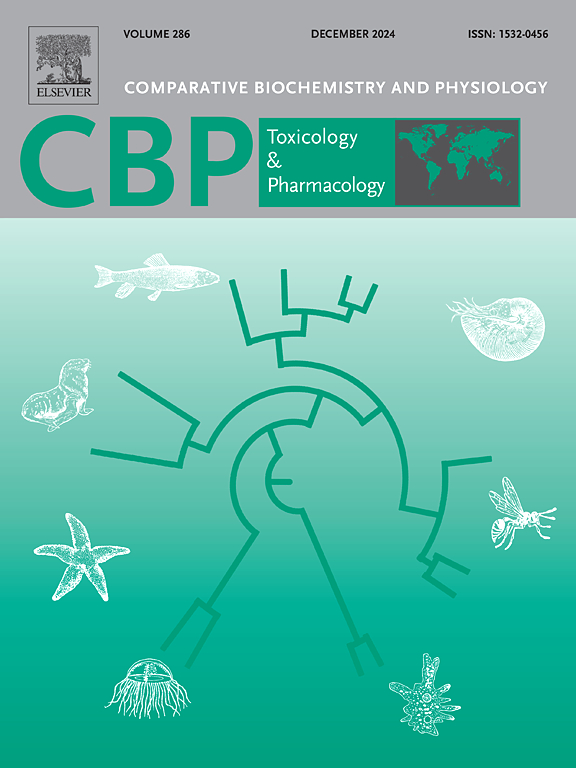虹鳟鱼从暴露于氯硝柳胺中迅速恢复过来:一种用于控制海七鳃鳗和蜗牛数量的杀鱼剂和杀软体动物剂。
IF 3.9
3区 环境科学与生态学
Q2 BIOCHEMISTRY & MOLECULAR BIOLOGY
Comparative Biochemistry and Physiology C-toxicology & Pharmacology
Pub Date : 2025-03-29
DOI:10.1016/j.cbpc.2025.110199
引用次数: 0
摘要
氯硝柳胺(2′,5-二氯-4′-硝基水杨酸analide)是一种用于控制劳伦森五大湖入侵的海七鳃鳗(Petromyzon marinus)的杀虫剂。它也是一种用于热带和亚热带淡水的杀软体剂,用于控制蜗牛种群,蜗牛是导致人类血吸虫病的血吸虫的中间宿主。虽然氯硝柳胺的毒性机制是已知的,但其对非靶鱼的相应生理影响尚未确定。为了更好地了解氯氯胺如何对非目标鱼类产生不利影响,我们将虹鳟鱼(Oncorhynchus mykiss)暴露在与环境相关的氯氯胺浓度0.150 mg L-1中(测量值 = 0.12-0.18 mg L-1)超过9 h,在此期间收集组织以测量能量储存和代谢物。氯硝柳胺暴露使脑ATP和糖原减少~ 50% %,肝糖原减少~ 40% %。肌肉中也观察到ATP、磷酸肌酸和糖原的减少,丙酮酸和乳酸的相应增加,以及代谢性酸中毒的发展(细胞内pH降低约0.2个单位)。这些干扰与线粒体氧化磷酸化受损和更依赖厌氧糖酵解产生ATP一致。值得注意的是,在不含氯硝胺的新鲜水中净化后,大脑、肝脏和肌肉的生理稳态在24 h内恢复。我们得出的结论是,非目标鱼类对氯硝柳胺敏感,但至少在虹鳟鱼中,这种影响在暴露停止后很容易逆转。类似的方法可用于确定其他鱼类在需要氯硝柳胺作为氨苄胺或杀螺剂的环境中对氯硝柳胺的敏感性和恢复力。本文章由计算机程序翻译,如有差异,请以英文原文为准。

Rainbow trout rapidly recover from exposure to niclosamide: A piscicide and molluscicide used to control sea lamprey and snail populations
Niclosamide (2′,5-dichloro-4′-nitrosalicylanalide) is a piscicide used to control invasive sea lamprey (Petromyzon marinus) in the Laurentian Great Lakes. It is also a molluscide used in tropical and sub-tropical freshwaters to control snail populations that are intermediate hosts to the blood flukes that causes schistosomiasis in humans. While the mechanism of niclosamide toxicity is known, its corresponding physiological effects on non-target fishes are not well-established. To better understand how niclosamide could adversely affect non-target fishes, rainbow trout (Oncorhynchus mykiss) were exposed to an environmentally relevant niclosamide concentration of 0.150 mg L−1 (measured = 0.12–0.18 mg L−1) over 9 h, during which tissues were collected for measurement of energy stores and metabolites. Niclosamide exposure reduced brain ATP and glycogen by ∼50 %, and liver glycogen by ∼40 %. Reductions of ATP, phosphocreatine and glycogen were also observed in muscle, with corresponding increases in pyruvate and lactate, plus development of a metabolic acidosis (∼0.2 unit decrease in intracellular pH). These disturbances were consistent with impaired mitochondrial oxidative phosphorylation and greater reliance on anaerobic glycolysis to generate ATP. Notably, physiological homeostasis was restored in the brain, liver, and muscle within 24 h after depuration in fresh, niclosamide-free water. We conclude that non-target fishes are susceptible to niclosamide, but at least in rainbow trout, the effects are readily reversed after exposure ceases. Similar approaches could be used to determine the susceptibility and resilience of other fishes to niclosamide in environments where it is required as a either a lampricide or a molluscicide.
求助全文
通过发布文献求助,成功后即可免费获取论文全文。
去求助
来源期刊
CiteScore
7.50
自引率
5.10%
发文量
206
审稿时长
30 days
期刊介绍:
Part C: Toxicology and Pharmacology. This journal is concerned with chemical and drug action at different levels of organization, biotransformation of xenobiotics, mechanisms of toxicity, including reactive oxygen species and carcinogenesis, endocrine disruptors, natural products chemistry, and signal transduction with a molecular approach to these fields.

 求助内容:
求助内容: 应助结果提醒方式:
应助结果提醒方式:


